This handy Spectrum Math Grade 7 Answer Key Chapter 7 Lesson 7.7 Representing Compound Events provides detailed answers for the workbook questions
Spectrum Math Grade 7 Chapter 7 Lesson 7.7 Representing Compound Events Answers Key
A sample space is a set of all possible outcomes (or possible results) for an activity or experiment. To determine the sample space, it is helpful to organize the possibilities using a list, chart, picture, or tree diagram.
Show the sample space for tossing a nickel, a dime, and a quarter.

There are 8 possible outcomes or possible results.
Make a tree diagram for each situation. Determine the number of possible outcomes.
Question 1.
The concession stand offers the drink choices shown in the table.
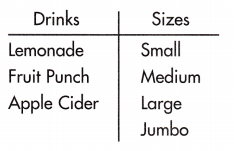
There are ______________ possible outcomes.
Answer:
There are 12 possible outcomes,
Explanation:

so, from the tree diagram no of outcomes for each drink is 4 and total number of possible outcomes are 4 x 3=12.
Question 2.
The Kellys are planning their vacation activities. The first day they can go to the zoo or the museum. The second day they can go to the pier or the dunes. The third day they have to choose sailing, swimming, or horseback riding.
There are ______________ possible outcomes.
Answer:
There are 16 possible outcomes,
Explanation:

therefore from the tree diagram the number of possible outcomes are 16.
One way to show sample space for compound events is with a chart. What is the sample space if you roll 1 die and flip 1 coin?
Chart
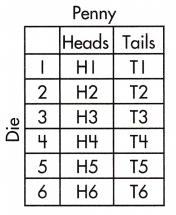
What is the sample space? It is 12, because there are 12 possible outcomes.
Solve each problem.
Question 1.
Juan flips a penny, a nickel, and a dime at the same time. How many different combinations of heads and tails can he get?
Answer:
8,
Explanation:
Given ,number of flips for each a penny, a nickel, and a dime is 2 ,so number of different combinations of heads and tails are
2 x 2 x 2 = 8.
Question 2.
Latisha has red, blue, and black sneakers; blue, tan, and white pants; and black and gray sweatshirts. How many different outfits can she make?
Answer:
18,
Explanation:
Given Latisha has number of sneakers are 3 , number of pants are 3 and number of sweatshirts are 2 so, therefore number of different outfits can Latisha make are 3 x 3 x 2 = 18.
Question 3.
Jonathan, Kaitlin, and Ling are trying to decide in what order they should appear during their talent show performance. They made this chart showing the possible orders. Can you show the same results using a tree diagram? (Remember, each person can appear only once in the 1, 2, 3 order.) What is the total number of possible orders?
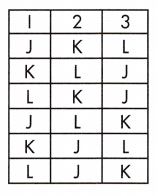
Answer:
6,
Explanation:

Given from the table the possible orders are 6.
Tables can be used to represent compound events that have two elements.
John rolls two dice. What is the probability that he will roll a sum of nine?
Step 1: Create a table with rows that match one part of the event and columns that match the other part of the event.
Step 2: Fill in the headers for your table with the possible outcomes for each part of the event.
Step 3: Fill in the table with the possible final outcomes
Step 4: Find .the total number of possible final outcomes (36) and the number of final outcomes with the desired characteristic (4) to calculate the probability.
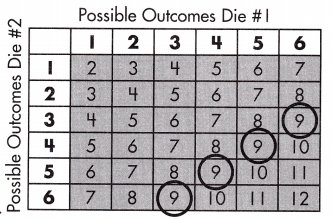
The shaded numbers ore the final outcomes, or sums when the outcomes are added together.
The probability is \(\frac{4}{36}\), or \(\frac{1}{9}\).
Create a table to solve the problems.
Question 1.
Erin is getting dressed in the morning. She is choosing from 4 skirts (black, brown, blue, and khaki) and 5 sweaters (black, blue, red, green, and yellow). What is the probability that she will wear both black and blue?
Answer:
\(\frac{2}{20}\) or \(\frac{1}{10}\),
Explanation:
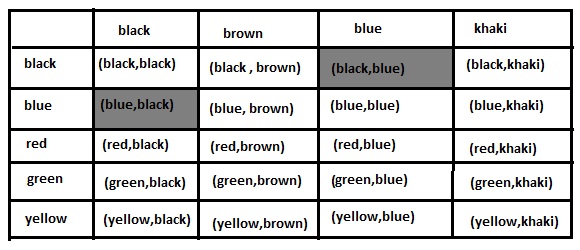
therefore the total number of outcomes are 20 so, the probability that Erin wear both back and blue is 2/20=1/10.
Question 2.
Michael is playing a game in which you spin a spinner numbered 1-8 first, and then roll a die numbered 1-6. What is the probability that he will spin and roll a sum of 10?
Answer:
\(\frac{5}{48}\),
Explanation:
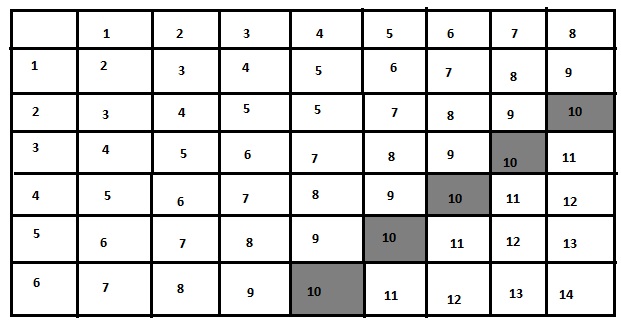
From the table number of outcomes are 48 and the probability that Michael spin and roll sum of 10 is 5/48.